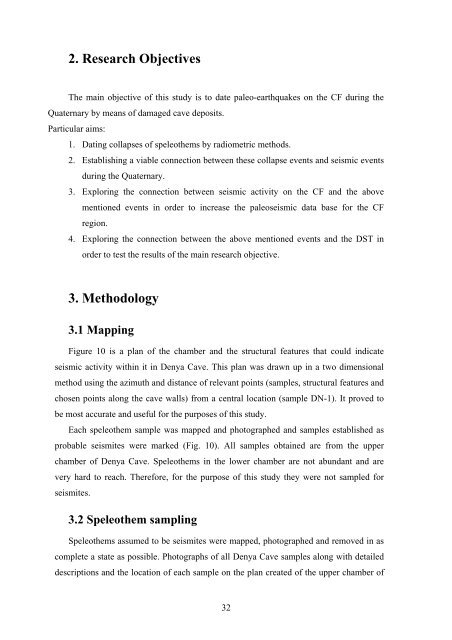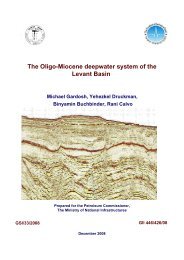tivity on the carmel faul
tivity on the carmel faul
tivity on the carmel faul
You also want an ePaper? Increase the reach of your titles
YUMPU automatically turns print PDFs into web optimized ePapers that Google loves.
2. Research Objectives<br />
The main objective of this study is to date paleo-earthquakes <strong>on</strong> <strong>the</strong> CF during <strong>the</strong><br />
Quaternary by means of damaged cave deposits.<br />
Particular aims:<br />
1. Dating collapses of speleo<strong>the</strong>ms by radiometric methods.<br />
2. Establishing a viable c<strong>on</strong>necti<strong>on</strong> between <strong>the</strong>se collapse events and seismic events<br />
during <strong>the</strong> Quaternary.<br />
3. Exploring <strong>the</strong> c<strong>on</strong>necti<strong>on</strong> between seismic ac<str<strong>on</strong>g>tivity</str<strong>on</strong>g> <strong>on</strong> <strong>the</strong> CF and <strong>the</strong> above<br />
menti<strong>on</strong>ed events in order to increase <strong>the</strong> paleoseismic data base for <strong>the</strong> CF<br />
regi<strong>on</strong>.<br />
4. Exploring <strong>the</strong> c<strong>on</strong>necti<strong>on</strong> between <strong>the</strong> above menti<strong>on</strong>ed events and <strong>the</strong> DST in<br />
order to test <strong>the</strong> results of <strong>the</strong> main research objective.<br />
3. Methodology<br />
3.1 Mapping<br />
Figure 10 is a plan of <strong>the</strong> chamber and <strong>the</strong> structural features that could indicate<br />
seismic ac<str<strong>on</strong>g>tivity</str<strong>on</strong>g> within it in Denya Cave. This plan was drawn up in a two dimensi<strong>on</strong>al<br />
method using <strong>the</strong> azimuth and distance of relevant points (samples, structural features and<br />
chosen points al<strong>on</strong>g <strong>the</strong> cave walls) from a central locati<strong>on</strong> (sample DN-1). It proved to<br />
be most accurate and useful for <strong>the</strong> purposes of this study.<br />
Each speleo<strong>the</strong>m sample was mapped and photographed and samples established as<br />
probable seismites were marked (Fig. 10). All samples obtained are from <strong>the</strong> upper<br />
chamber of Denya Cave. Speleo<strong>the</strong>ms in <strong>the</strong> lower chamber are not abundant and are<br />
very hard to reach. Therefore, for <strong>the</strong> purpose of this study <strong>the</strong>y were not sampled for<br />
seismites.<br />
3.2 Speleo<strong>the</strong>m sampling<br />
Speleo<strong>the</strong>ms assumed to be seismites were mapped, photographed and removed in as<br />
complete a state as possible. Photographs of all Denya Cave samples al<strong>on</strong>g with detailed<br />
descripti<strong>on</strong>s and <strong>the</strong> locati<strong>on</strong> of each sample <strong>on</strong> <strong>the</strong> plan created of <strong>the</strong> upper chamber of<br />
32

















